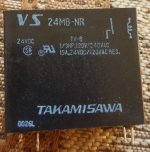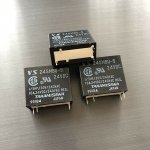Hello I am new here. I am not sure if I am posting this in the right place.
I have a Sherbourn 5 channel amp. The relays have started to give me problems. I went on the web to try and find replacements but cant find the same ones. My amp uses 15 amps relay and I found ones that are only 10 amps. Do you think these relays could work? I have included pictures of both relays. The first one is from my amp, the second one are the ones I found on ebay.
I have a Sherbourn 5 channel amp. The relays have started to give me problems. I went on the web to try and find replacements but cant find the same ones. My amp uses 15 amps relay and I found ones that are only 10 amps. Do you think these relays could work? I have included pictures of both relays. The first one is from my amp, the second one are the ones I found on ebay.
Attachments
How much of a current do you think there will be passing through relay contacts? Suppose this is a 200W/channel amp. Sine wave treated, at 8 ohms load, there will be 5Arms (40Vrms) flowing. One 10A relay/channel should suffice.
Relay contacts can be cleaned, but not everyone is ready to attemt one. I clean relays and switches with a fiberglass pen. This stuff effectively and swiftly scratches the deposits away and puts it in function as "new". You need some patience and care not to damage the device while doing so. Small fragments of fiberglass always break while you perform the cleaning and this is best not to touch, just clean with a hoover.
Relay contacts can be cleaned, but not everyone is ready to attemt one. I clean relays and switches with a fiberglass pen. This stuff effectively and swiftly scratches the deposits away and puts it in function as "new". You need some patience and care not to damage the device while doing so. Small fragments of fiberglass always break while you perform the cleaning and this is best not to touch, just clean with a hoover.
@Lojzek thanks for taking the time to reply. My amp is 200w per channel. I guess then that those replacements would be ok. My friend and I did cleaned the relays, but I read that cleaning them is not a long term solution, since they tend to fail again in few months. That is the reason I want to replace them and also after the clean up, I lost one channel. My guess is that we damaged one of the relays during the cleaning. Now I have no choice but to replace it.
I found an omron at mouser (https://www.mouser.com/ProductDetai...PZ-1A-E-DC24/?qs=vmHwEFxEFR%2BcM%2BOMshUVEg==) that has a 24V coil and 20A contacts. I think I saw a end of life notice on the original relay when I searched.
I would use those relays if u had them.
These Omrons are another favourite
https://omronfs.omron.com/en_US/ecb/products/pdf/en-g2r.pdf
Remember to look at the datasheet curve that shows max breaking DC current at your supply voltage.
A 10Amp relay can't reliably break 10A at 80V DC for example
These Omrons are another favourite
https://omronfs.omron.com/en_US/ecb/products/pdf/en-g2r.pdf
Remember to look at the datasheet curve that shows max breaking DC current at your supply voltage.
A 10Amp relay can't reliably break 10A at 80V DC for example
Last edited:
With speaker relays it’s really the interruption rating you have to worry about. It needs to open under fault conditions without pitting the contacts up too much. How much fault current? The power supply voltage divided by the DC resistance of the voice coil. And that needs to be an inductive (AC) rating due to the few mH of inductance of the VC. This is how much current it could be called on to interrupt, if the amp started putting out DC due to a failure. It only would need to do that non-repetitively but you would want it to be non-destructive to the relay. 15 amps is a little thin for this sort of power level (80 volt supply divided by 4 ohms is 20 amps) so if it’s a choice between a 10 amp and a 20 I’d go with a 20. The relay may be called upon to open for other reasons, possibly repetitively, say detecting subsonics, a few volts of DC offset, or a turn-on/off thump, but the current drawn by the speaker during those events would be much lower. But sizing it based on those events is ill-advised. A 15 amp relay may safely open under a DC to the speaker fault, but a 5 amp one could NOT be counted on to do so. A 20 or 30 certainly would and if you find one that fits, use it.
Trying to use the relay as a fuse to prevent overcurrent is stupid. Some amp manufacturers do, and the result is often blown amps and welded relay contacts as well as blown speakers. You can’t protect against stupid. Better amps will have something else besides a mechanical relay in series with the speaker for overcurrent limiting, so hundred amp ratings are not needed in a properly designed amp.
Trying to use the relay as a fuse to prevent overcurrent is stupid. Some amp manufacturers do, and the result is often blown amps and welded relay contacts as well as blown speakers. You can’t protect against stupid. Better amps will have something else besides a mechanical relay in series with the speaker for overcurrent limiting, so hundred amp ratings are not needed in a properly designed amp.
I found an omron at mouser (https://www.mouser.com/ProductDetai...PZ-1A-E-DC24/?qs=vmHwEFxEFR%2BcM%2BOMshUVEg==) that has a 24V coil and 20A contacts. I think I saw a end of life notice on the original relay when I searched.
Thanks for the reply. Yes, I saw that the original relay is discontinued. The one you mentioned has a switching voltage of 250VAC. My country uses 120 volts. Would that be a problem?
A 15 amp relay may safely open under a DC to the speaker fault, but a 5 amp one could NOT be counted on to do so. A 20 or 30 certainly would and if you find one that fits, use it.
It's worse than you think. If there is a DC fault, then you will have (in this case) to break a 80Vdc at 10A. And those relays are rated to break 10-15A at 24V. This means that they will not be able to break the DC arc that will form.
Same issue with fuses, you need fuses rated to break the DC voltage. A lot of fuses are for DC rated up to something around 30Vdc.
The arc itself will extinguish when the energy stored in the voice coil is dissipated. This energy is limited, but not zero. You don’t want that total energy to be large enough that it will physically weld the contacts. The higher rated the contacts, the more they will take before that happens.
With speaker relays it’s really the interruption rating you have to worry about. It needs to open under fault conditions without pitting the contacts up too much. How much fault current? The power supply voltage divided by the DC resistance of the voice coil. And that needs to be an inductive (AC) rating due to the few mH of inductance of the VC. This is how much current it could be called on to interrupt, if the amp started putting out DC due to a failure. It only would need to do that non-repetitively but you would want it to be non-destructive to the relay. 15 amps is a little thin for this sort of power level (80 volt supply divided by 4 ohms is 20 amps) so if it’s a choice between a 10 amp and a 20 I’d go with a 20.
So if I understand correctly you are saying that the actual relay that are in the amps right now are in fact underpowered? So I can go with a higher amp rating as long as it has the same 24 volts and i would not have any problem?
I ordered these G5PZ-1A-E DC24 Omron Electronics | Mouser hoping the work fine
The thing that kills these relays over time is that the contacts oxidize. The relay is self cleaning if it opens and closes on a some current. I used to put relays on all my amp designs for the car audio market, and they were reliable because car stereos generally come on at whatever volume level they were playing when the driver shut off the ignition.
Home audio amps often power up and down with all signals off, so the relay opens and closes with no current. I recommend, when you turn your amp off, that it be playing music at a moderate level at that moment, so the relay oxidation can clean itself.
I would not replace a relay with a lower current model. The original designers know what current limit they set for the amp, and picked a suitable relay. Okay to go a little bit higher. Let the replacement switch live signals, and it will last longer.
Home audio amps often power up and down with all signals off, so the relay opens and closes with no current. I recommend, when you turn your amp off, that it be playing music at a moderate level at that moment, so the relay oxidation can clean itself.
I would not replace a relay with a lower current model. The original designers know what current limit they set for the amp, and picked a suitable relay. Okay to go a little bit higher. Let the replacement switch live signals, and it will last longer.
The arc itself will extinguish when the energy stored in the voice coil is dissipated. This energy is limited, but not zero. You don’t want that total energy to be large enough that it will physically weld the contacts. The higher rated the contacts, the more they will take before that happens.
It's nothing to do with dissipating energy of the voice coil. It's handling breaking a sustained DC output if the amplifier develops a fault - the fuses may not necessarily blow and even if they do, you could still have to deal with dumping the energy stored in the supply capacitors.
Very few relays will survive breaking an arc completely intact... but what you DONT want is for the relay to weld shut, or worse, bridge all the contacts because the armature and associated contacts just melted trying to interrupt the fault
What causes the arc is the stored inductive energy. If the current is purely resistive the relay will simply interrupt it, no matter how high it is. That NEVER happens because all circuits have inductance - even a few uH will cause an arc when you open the contacts. The voltage simply peaks up when you try to interrupt the flow, and the energy must go somewhere. Radiated energy and heat. What causes the contacts to weld? The energy 1/2 LI squared. More of that means more molten metal and oxide.
Again, you're thinking about the wrong thing. The relay is there to disconnect the speaker when the amp fails. The amp's output devices have shorted and are connecting a direct DC source to the speaker, which is a low resistance path to ground. You are talking about interrupting whatever energy the supply capacitors and transformer can supply - this is going to make for a hot, intense arc. Nothing to do with inductive storage.
- Status
- This old topic is closed. If you want to reopen this topic, contact a moderator using the "Report Post" button.
- Home
- Amplifiers
- Solid State
- Question about relays

